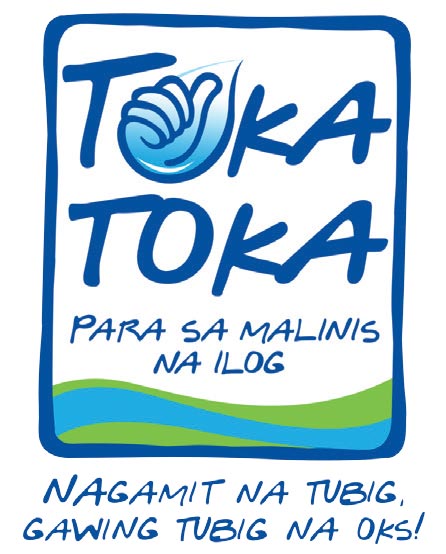Sustainability at Manila Water
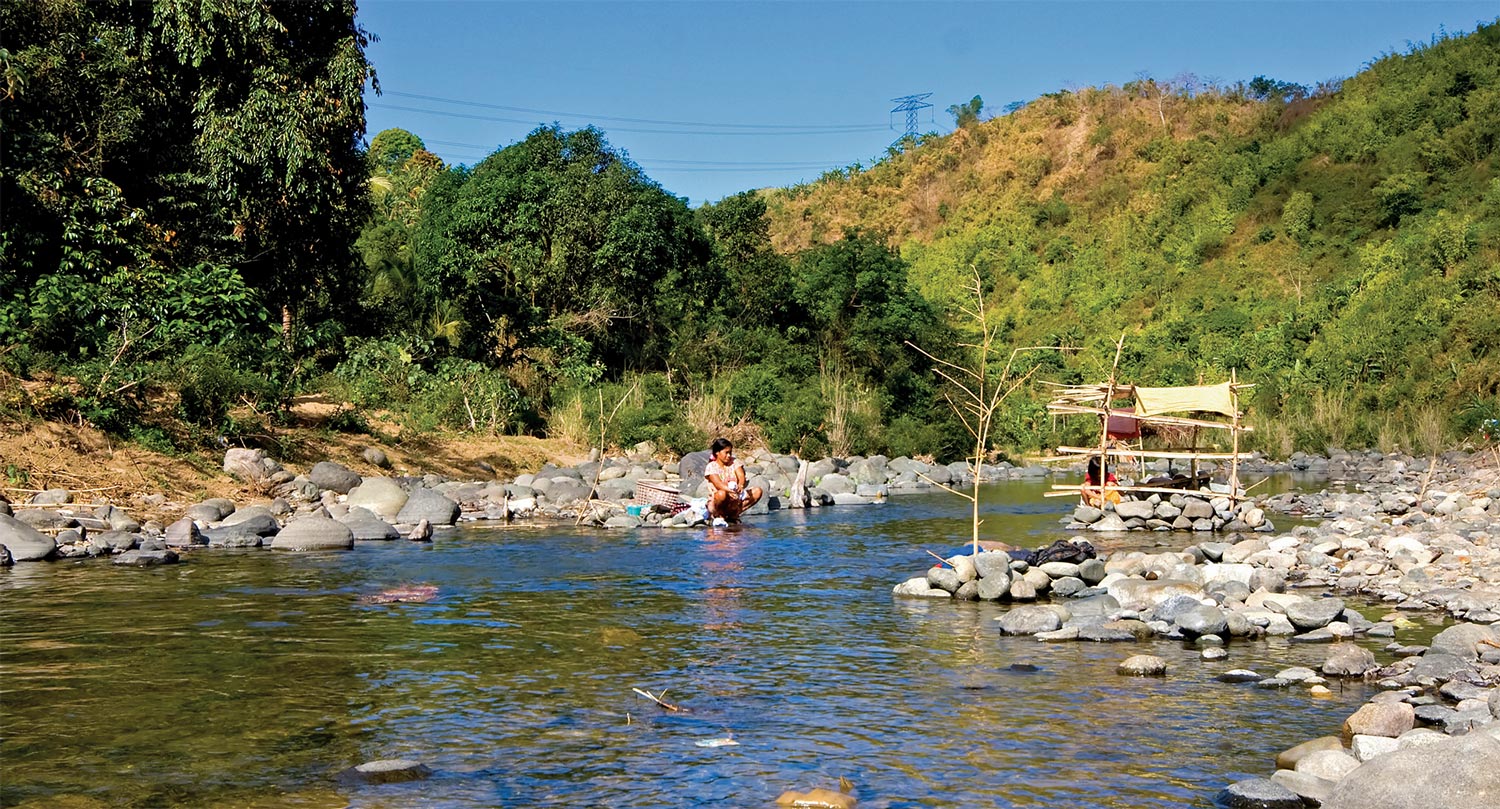
Sustainable operations of Manila Water is only as strong as the ecosystem services on which it depends. It is therefore an imperative for the company to ensure the overall health of the physical environment, taking into consideration its impact to, and impact from, the whole water cycle, from managing water sources down to managing water that has been used prior to return to rivers, lakes and the sea. This holistic approach allows Manila Water to optimize current and future resources while continuing to cater to customer needs. Manila Water remains committed to championing environmental protection, and recognizes the valuable support and shared responsibility various stakeholders have extended to move forward in the common goal of protecting the environment.
MANAGING WATER RESOURCES AND WASTEWATER
In order to effectively manage water supply, the company tracks water withdrawal by source. This ensures that water withdrawals from groundwater and surface water sources, as well as its discharges are within regulatory limits. By tracking these metrics, the company is able to provide insights for all stakeholders on the need for water source development, collective action on water conservation and its contribution to the restoration of ecosystems such as Manila Bay and Boracay Island.
The Company’s total water withdrawal in 2019 was 843.64 million cubic meters (MCM) of surface and groundwater across all its operating subsidiaries in the Philippines and Vietnam.
Prior to 2019, the Manila Concession abstractions from wells were constant at around 0.29 percent of total water supply. The water crisis prompted the company to look for ways to augment the dwindling supply from Angat and La Mesa, and special permission was secured from the MWSS and NWRB to rehabilitate the old wells which were constructed before privatization and during the 1997-98 El Niño crisis. Special permit was also granted to construct new wells in strategic locations for use during summer. It is foreseen that partial dependence on wells will be the norm for water supply until MWSS completes the major water source. Manila Water regularly reports total groundwater withdrawals to the NWRB for monitoring and assessment if aquifer reserves remain intact.
Water Withdrawalby source (in MCM)
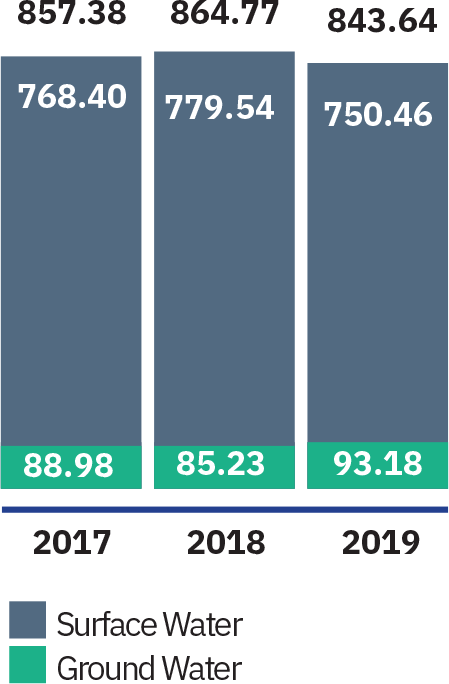

Surface Water
Ground Water
Wastewater Collected and Treated
| 2017 | 2018 | 2019 | |
|---|---|---|---|
|
Wastewater Treated, MCM |
56.42 |
62.42 |
64.16 |
|
Organic pollution load removed, tons of BOD1 |
9,087 |
9,102 |
13,440 |
|
CO2 Avoided, tons CO2 (eq)2 |
57,248 |
57,346 |
79,085 |
Note:
Water that has been used by customers was collected and fully treated in 61 wastewater treatment facilities in order to comply with effluent standards, protect public health, and restore water bodies. In total, the company treated a total of 64.16 MCM of wastewater which resulted in the diversion of 13,440 tons of organic pollutants from waterways.
There are three approaches in collecting water used by the customers: through separate sewer lines, combined sewer-drainage system or by septic tank desludging. The company consistently meets effluent water quality standards set by regulatory authorities. In 2019, there was a 2 percent increase in the volume of wastewater treated brought about by 130,973 new sewer connections and the completion/acquisition of 1 additional sewage treatment facility.
Wastewater Treatment Plants
| No. of wastewater treatment plants | Capacity, m3/day | |
|---|---|---|
|
Boracay Water |
2 |
11,500 |
|
Clark Water |
1 |
30,000 |
|
Estate Water |
16 |
51,653 |
|
Laguna Water |
2 |
11,070 |
|
Manila Concession |
40 |
310,683 |
|
Total |
61 |
414,906 |
In 2018, Manila Water submitted its compliance action plan to the Department of Environment and Natural Resources (DENR) and Laguna Lake Development Authority (LLDA) in response to the Revised General Effluent Standards of 2016 (DAO 2016-08) which require the removal of nutrients such as nitrogen and phosphorus to further reduce algal growth in water bodies. While the MWSS regulatory office has approved the proposed investments for facility retrofits, the environmental regulator has not yet given its full approval for the said action plan.
ENHANCING OPERATIONAL EFFICIENCY
Operation efficiency is key to Manila Water’s business, primarily to ensure affordability of its services and with environmental benefits as a corollary outcome. Opportunities to reduce negative environmental impacts and provide continuous services includes optimizing water efficiency, reducing wastes and emissions, and educating the consumers. These efforts further improve the company’s environmental performance.

Wastewater Treated, MCM
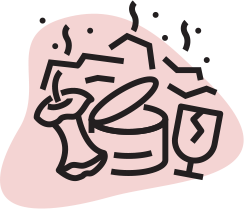
Organic pollution load removed, tons of BOD
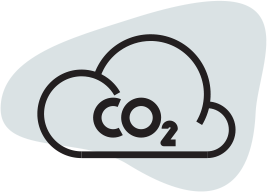
CO2 Avoided, tons CO2 (eq)
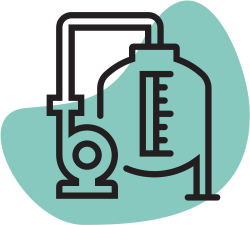
Wastewater Treatment Plants
Non-revenue Water
NRW in % (End-of-Period)
| Company | Start of operations | NRW at the start of operations | 2017 | 2018 | 2019 |
|---|---|---|---|---|---|
|
Manila Concession |
1997 |
63.0% |
11.6% |
11.4% |
10.4% |
|
Laguna |
2009 |
48.0% |
19.5% |
16.7% |
18.0% |
|
Boracay |
2010 |
29.0% |
22.5% |
13.8% |
9.8% |
|
Clark |
2011 |
15.0% |
5.5% |
6.7% |
7.4% |
|
Cebu |
2015 |
5.0% |
3.0% |
2.0% |
3.0% |
|
Estate |
2016 |
47.0% |
34.0% |
38.0% |
30.0% |
|
Bulacan |
2017 |
50.0% |
50.0% |
34.3% |
24.0% |
|
Calasiao |
2018 |
12.1% |
- |
5.5% |
6.8% |
|
Obando |
2018 |
52.9% |
- |
47.7% |
49.8% |
|
Kenh Dong |
- |
- |
- |
3.0% |
3.0% |
|
Thu Duc |
- |
- |
- |
1.8% |
0.0% |
Non-revenue water (NRW), generally defined as the total amount of treated water which do not reach the customer taps, usually due to pilferage, pipe leaks and metering error, has always been a vital operating parameter for any water utility. Considering the recent onset of the water supply deficit, it has become vital for the company to strengthen its NRW program which involves leak detection, pipe replacement, meter inspection and calibration, and the timely resolution of incidents and a proactive coordination with benchmark customers and other stakeholders such as third-party contractors, national government agencies and local government units.
Through the NRW program, the Manila Concession recovers around 750 million liters per day (MLD) relative to the systems losses inherited in 1997 – a volume that is equivalent to the output of a mediumsized dam. This provides additional water supply to more customers and alleviates the impact of the delayed investments of the water security agency on new water sources. In 2019, at the height of the summer water crisis, the Manila Concession achieved an all-time low of 7.4 percent NRW.
CHEMICALS
Consistent with its sustainability commitment of safeguarding health and safety, Manila Water puts a premium on the potability and compliance of drinking water with standards of the Department of Health. To help ensure the customers can trust the quality of water at the tap, the production process uses non-renewable chemicals such as alum, blended phosphate, chlorine, lime, polyaluminum chloride (PAC), polymer, and sodium hydroxide. In wastewater treatment, the main treatment mode is biological but the solids management and disinfection processes use polymer, PAC and chlorine. Chemical inputs are consistenly among the top three costs (along with manpower and electricity) for both water supply and wastewater operations.
Chemical Consumption, tons
| 2017 | 2018 | 2019 | |
|---|---|---|---|
|
Water Supply |
11,899 |
23,656 |
97,072 |
|
Wastewater |
1,506 |
2,517 |
2,485 |
Chemical Consumption Intensity
| 2017 | 2018 | 2019 | |
|---|---|---|---|
|
Water Supply, tons per MCM raw water abstracted |
14.34 |
28.50 |
115.06 |
|
Wastewater, tons per MCM wastewater treated |
26.70 |
40.38 |
39.02 |
In 2019, the company’s water treatment facilities across the Philippines, including its operations in Asia Pacific used a total of 97,072 tons of non-renewable chemicals, with an increase of 310% across the enterprise. This is mainly attributed to the high turbidity at Ipo and La Mesa brought about by strong typhoons and rains, inclusion of chemical consumption from Cardona Water Treatment Plant, and additional chemicals used to treat raw water from deepwells. Various operational improvements and initiatives, such as watershed protection and rehabilitation, aim to prevent soil erosion which affects the turbidity of raw water.
ENERGY AND EMISSIONS
Electricity consumption, million kWh
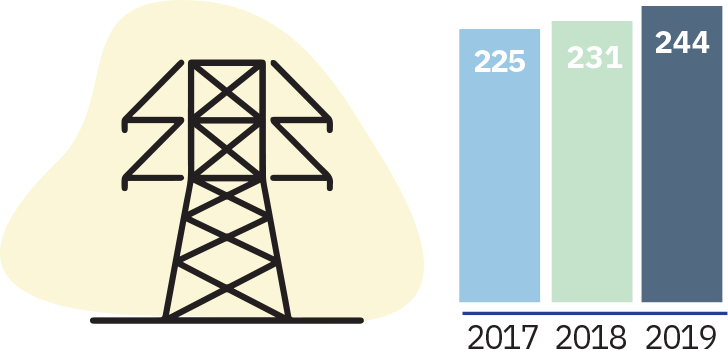
Note: Restated 2017 and 2018 Electricity Consumption due to conversion of MWTS’ electricity from kilowatt to kilowatt per hour.
Fuel Consumption, thousand liters
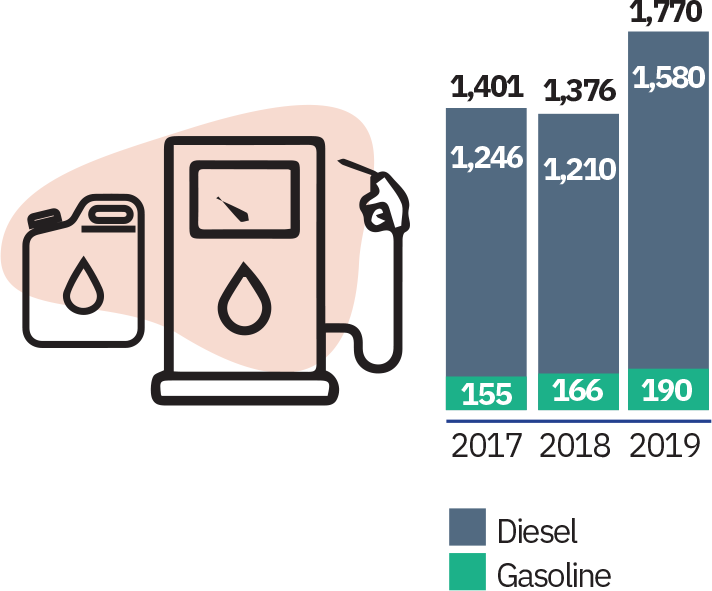
Energy Consumption, GigaJoules (GJ)
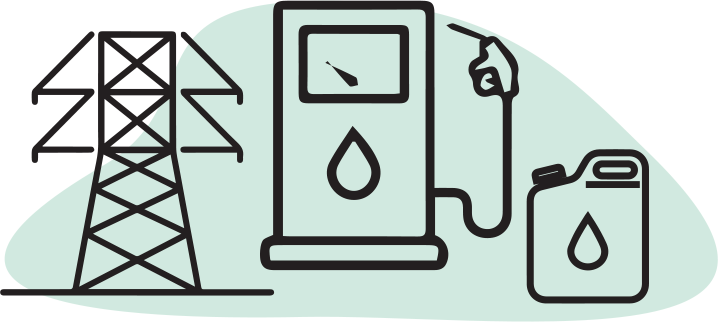
| 2017 | 2018 | 2019 | |
|---|---|---|---|
|
Electricity |
809,193 |
831,439 |
879,884 |
|
Gasoline |
5,380 |
5,775 |
6,607 |
|
Diesel |
48,236 |
46,842 |
61,153 |
|
Total |
862,810 |
884,057 |
947,645 |
Manila Water’s water utility operations consume significant quantities of energy, especially when topography dictates the need for lifting water from lower elevations. After manpower, electricity is the second biggest operating expense of the company, requiring Manila Water to work in achieving a high level of energy efficiency, promote renewable energy generation and responsibly utilize transportation to help minimize the impact of tariff and contribute to minimizing greenhouse gas emissions.
The company established an Energy Management System (EnMS) for operating facilities to achieve continuous energy performance improvement. Several energy efficiency initiatives have been undertaken and are ongoing, such as demand-based network management, system load balancing, pump efficiency testing and refurbishment, wastewater ‘Project Zero’, and ‘Biggest Loser: Trimming the Energy Bulge’ competition and clean fleet initiatives. In addition, the company has installed variable frequency drives, upgraded to LED lamps and replaced air conditioners to inverter-type. Philippines subsidiaries, on the other hand, continue to implement network pipe re-sizing, equipment upgrades, automation, and treatment process optimization and other operational improvements to contribute to energy efficiency.
Greenhouse Gas Emissions, tons CO2e
| 2017 | 2018 | 2019 | |
|---|---|---|---|
|
Scope 1 a |
3,702 |
3,632 |
4,638 |
|
Scope 2 b |
157,059 |
164,015 |
172,268 |
|
Scope 3 c |
1,653 |
1,611 |
1,672 |
|
Total |
162,414 |
169,258 |
178,577 |
GHG Intensity, tons CO2e
| 2017 | 2018 | 2019 | |
|---|---|---|---|
|
Water Supply Operations, tons CO2 (eq)/ MCM billed volume |
189 |
195 |
203 |
|
Used Water operations, tons CO2e/ MCM used water treated |
191 |
191 |
303 |
The Manila Concession and the other subsidiaries measure overall carbon footprint using the Greenhouse Gas Protocol: direct carbon dioxide emissions (Scope 1) from fuel used by the facilities and company’s own vehicles, indirect emissions (Scope 2) from electricity bought by facilities and offices, and indirect emissions (Scope 3) from fuel used by septic tank desludging contractors. The company’s Climate Change Policy, while putting more emphasis on adaptation measures and resiliency, makes a commitment to help mitigate carbon emissions primarily through energy efficiency efforts. The 1,166,786 trees planted and nurtured in watersheds and surrounding areas offset some carbon emissions. The total organic pollution removed in wastewater treatment in 2019 translates to 79,085 tons of carbon dioxide equivalent of avoided methane formation, using the latest updated factors generated by the Intergovernmental Panel on Climate Change.
NON-HAZARDOUS AND HAZARDOUS WASTE
Non-hazardous Waste Disposed, tons
Biosolids
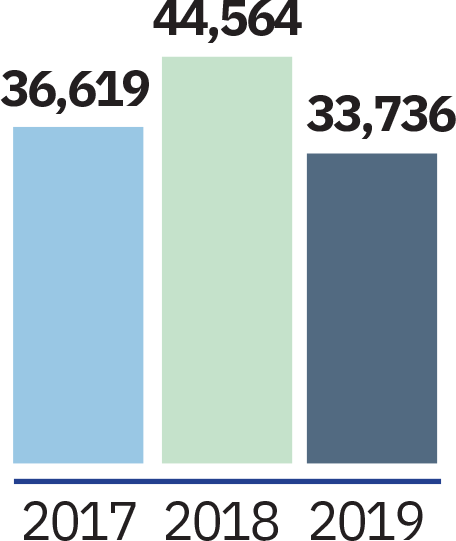
Grit and Screenings
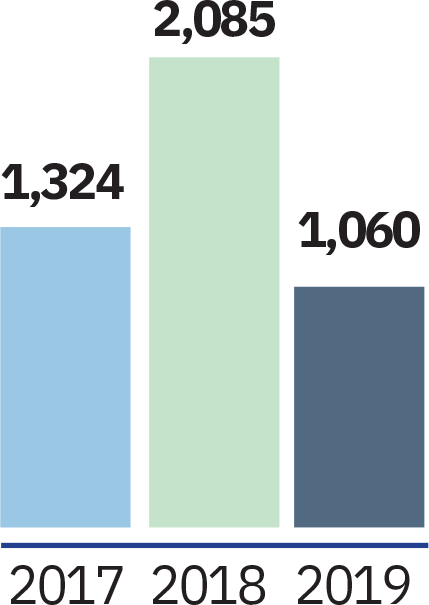
The main solid wastes of the Company are grits and screenings, and biosolids generated from treatment facilities. The company ensures that these waste streams are fully accounted for, disposed of in accordance with regulations, and wherever possible, find a suitable use that extends their economic value. Biosolids from the Manila Concession and operations in Boracay are sent to a compost processing facility in Tarlac that uses dried sludge with high nutrient content from various industries. The resulting soil conditioner is applied to sugarcane fields in lahar-affected (volcanic ash) areas in Central Luzon. Grits and screenings not regularly collected by the local governments’ solid waste services are hauled by service providers and are disposed in DENR-accredited sanitary landfills.
Hazardous wastes generated by the company are spent chemicals, used lead acid batteries, used oil, and e-wastes. The Manila Concession donates its used oil and used-lead acid batteries to ABS-CBN Foundation’s Bantay Langis and Bantay Baterya programs in exchange for tax credits, while other hazardous wastes are properly transported, treated, and disposed of by DENR-accredited hazardous waste service providers. In 2019, a total of 47.85 tons of hazardous wastes were properly transported, treated, and safely disposed.
Hazardous Waste Generated, tons
| 2017 | 2018 | 2019 | |
|---|---|---|---|
|
Busted fluorescent lamps |
16.56 |
7.45 |
0.56 |
|
Contaminated materials |
1.03 |
0.23 |
1.76 |
|
Asbestos cement pipes |
21.82 |
- |
- |
|
Other hazardous wastes |
30.20 |
45.00 |
0.41 |
|
Spent Chemicals |
0.67 |
0.10 |
0.34 |
|
Used lead-acid batteries |
7.53 |
2.05 |
3.24 |
|
Waste oil |
64.13 |
6.56 |
13.69 |
|
Grease traps |
1.18 |
6.38 |
7.72 |
|
Electronic Wastes |
1.14 |
0.03 |
- |
|
Total |
144.26 |
67.80 |
27.72 |
ADVOCATING ENVIRONMENTAL STEWARDSHIP
Manila Water continues to maintain strong partnerships with local communities, especially through the customer kasanggas who act as force multipliers that help in communications and advocacies.
Since 2006, Manila Water has been organizing the Lakbayan tour, whose objective is to provide an opportunity for members of the public to experience the water trail and foster an in-depth understanding of the value of water conservation and managing water after it is used. Lakbayan takes visitors to a water source, a water treatment plants and finally a wastewater treatment plant. Since the program’s inception, 102, 753 individuals from various sectors have benefitted from the Lakbayan experience.
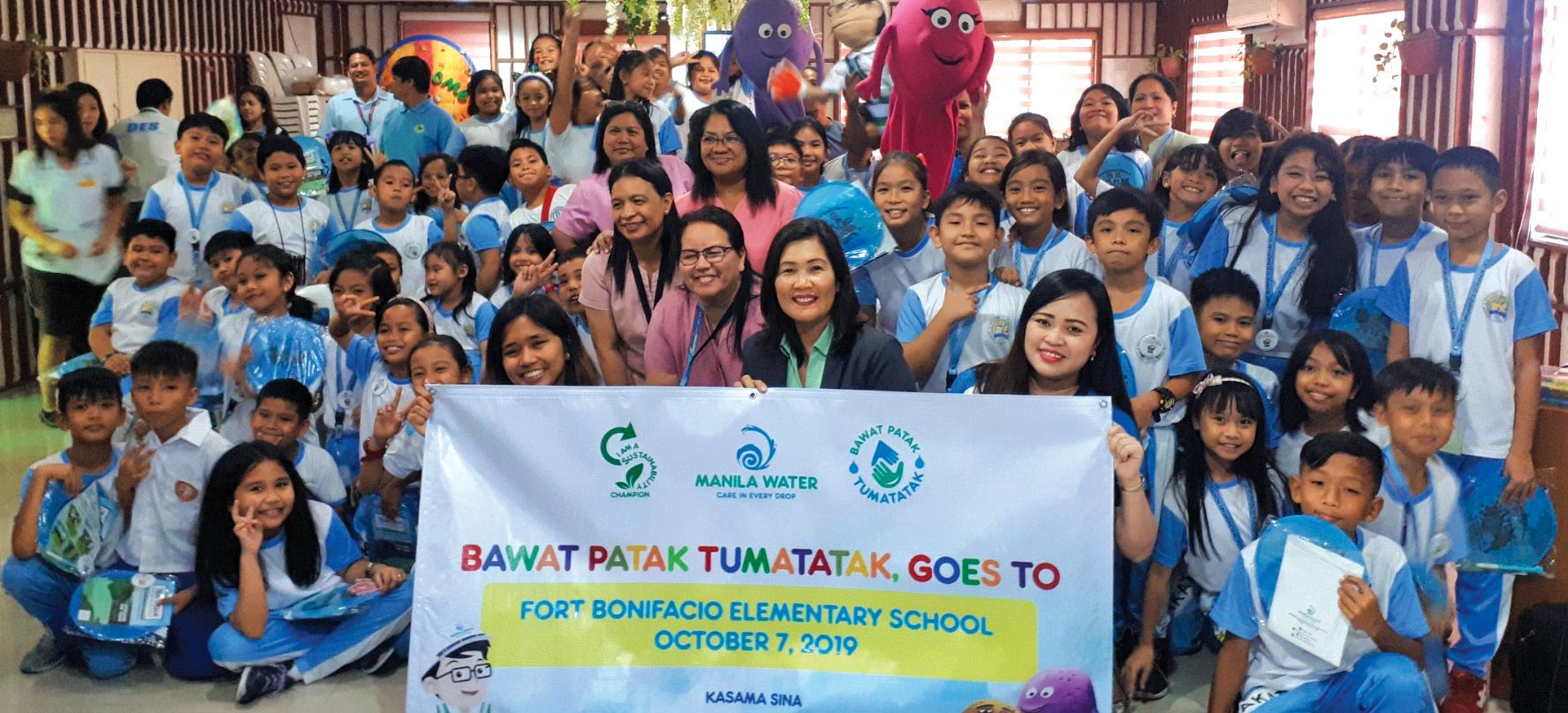
The Toka Toka Movement is Manila Water’s advocacy program that aims to inform and educate people on the need for wastewater management in communities, the value of personal commitment and the collective impact of individual actions for the environment such as having septic tanks desludged, connecting houses to sewer lines where available, segregating solid waste and spreading the gospel of environmental sustainability among one’s family and friends. This multi-stakeholder effort banks on the strategy of cooperative volunteerism from program partners such as local government units, national government agencies, businesses, media, the academe and the non-profit sector. In 2019, the Manila Concession has partnered with a total of 34 government and non-government organizations to sustain the campaign. Boracay Water developed its own local version called Amot Amot Para Sa Malimpyong Boracay, and Laguna Water also launched its TSEK ng Bayan (Tamang Sanitasyon Equals Kalusugan, Kalinisan, at Kaunlaran ng Bayan). All three programs have received awards for excellence in communications.
Launched in 2015, ‘Bawat Patak Tumatatak’ Goes to School, is a sub-program of the Bawat Patak Tumatatak (“every drop makes a mark”) employee engagement program, which gives volunteer employees an opportunity to communicate the importance of proper environmental practices to elementary school students. Activities involve short lectures, puppet shows and games which incorporate messages on personal responsibility and environmental sustainability. The annual culminating event is an interschool competition of student science projects with environmental value. As of end of 2019, the program has partnered with 36 elementary schools, reached 3,658 grade school students and tapped the assistance of 398 Manila Water volunteer employees.
